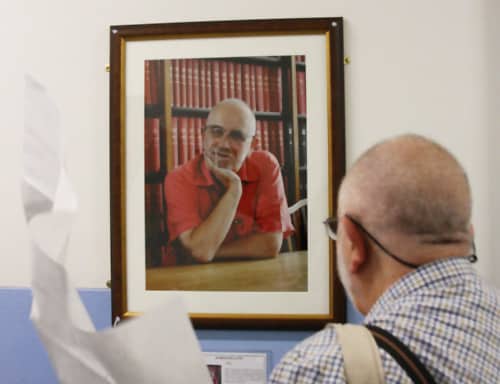
By Matin Durrani
Anyone who gets invited to an event that’s being held on April Fools’ Day is bound to think there’s something fishy going on. But last Friday’s meeting to celebrate the 75th birthday of Bristol University physicist Michael Berry was a genuine commemoration of his career, although it did have its lighter moments.
Grandly entitled “Physics, Art, Mathematics, Science”, the meeting was intended to reflect Berry’s extensive and wide-ranging interests, which stretch from the physics of waves and quantum phenomena to optics, tidal bores and magnetic levitation. (There’s also a phenomenon called the Berry phase, although I understand Berry himself is reluctant to use that term.)
It’s difficult to summarize Berry’s many contributions to physics – he has written approaching 500 papers – so I’m going to take the easy way out and instead point you at his excellent website, where you can easily get lost down lots of entertaining and stimulating rabbit holes.
If there’s one item on his site I can recommend, it’s his description of how his work on the mathematics of magnetic levitation led him to share the 2000 IgNobel Prize for Physics with the future (genuine) Nobel laureate Andre Geim, who in 1997 levitated a frog using a powerful permanent electromagnet while at Bristol.
Everyone has their own way of doing physics and I think the talk by Berry’s one-time student Jonathan Keating – now a maths professor at Bristol – gave the best flavour of Berry’s own, somewhat unique, approach. Keating recalled sitting one day in a launderette in Bristol when he started reading one of Berry’s papers, which described a link between quantum mechanics and the distribution of prime numbers.
“It was”, Keating described, “a bold and wonderfully speculative paper.” Berry had seen a connection between two seemingly unrelated fields that until then had gone unnoticed. (The paper appeared in a journal published by IOP Publishing, which co-sponsored the meeting and also publishes Physics World.)
It might sound pompous to talk about an institution’s “intellectual atmosphere” but Berry has certainly helped to shape that of the physics department at Bristol. One reason is that Berry – unusually in the modern day – has spent almost his entire career there, joining the department as a postdoc more than 50 years ago.
He’s had offers, of course, to move to top institutions elsewhere in the world but has instead preferred to stay in the city where, as he told me after the conference dinner, he could walk to work along pleasant, tree-lined streets.
Keating for me encapsulated Berry in an anecdote in which he recalled first arriving at Bristol 30 years ago, where he was met by his future PhD supervisor dressed in an Indian tunic. “It seemed”, Keating concluded, “to be an act of bold individualism that I admired.”


